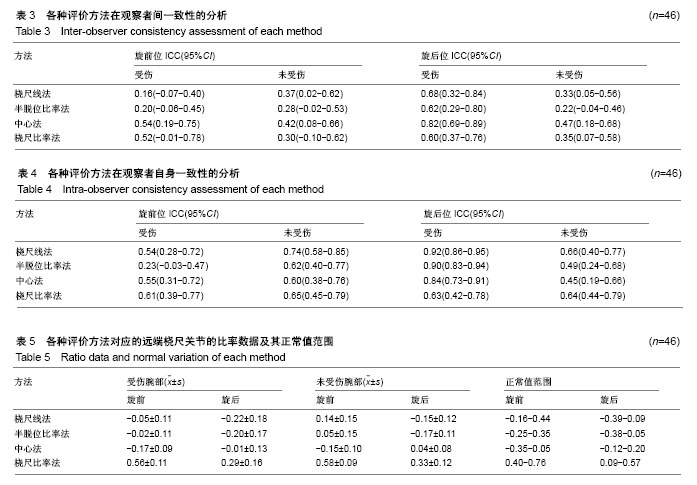| [1] Rehman FU, Ajmal M. Effect of malunited fractured distal end of radius on the morphometric parameters of distal radioulnar joint. JMS. 2016; 32(3):124-128. [2] Wijffels MME, Keizer J, Buijze GA, et al. Ulnar styloid process nonunion and outcome in patients with a distal radius fracture: a meta-analysis of comparative clinical trials. Injury. 2014;45(12): 1889-1895. [3] Sammer DM, Shah HM, Shauver MJ, et al. The effect of ulnar styloid fractures on patient-rated outcomes after volar locking plating of distal radius fractures. J Hand Surg. 2009;34(9):1595-1602. [4] Lindau T, Adlercreutz C, Aspenberg P. Peripheral tears of the triangular fibrocartilage complex cause distal radioulnar joint instability after distal radial fractures. J Hand Surg. 2000;25(3):464-468.[5] Lindau T, Hagberg L, Adlercreutz C, et al. Distal radioulnar instability is an independent worsening factor in distal radial fractures. Clin Orthop Relat Res. 2000;376(376):229. [6] Wijffels M, Ring D. The influence of non-union of the ulnar styloid on pain, wrist function and instability after distal radius fracture. J Hand Microsurg. 2011;3(1):11-14.[7] Krämer S, Meyer H, O'Loughlin PF, et al. The incidence of ulnocarpal complaints after distal radial fracture in relation to the fracture of the ulnar styloid. J Hand Surg Eur Vol. 2013;38(7):710-717.[8] Dy C J, Jang E, Meyers K, et al. The impact of coronal alignment on distal radioulnar stability following distal radius fracture : not a clinical study. J Hand Surg. 2013;38(10):e7-e8.[9] Kitamura T, Moritomo H, Arimitsu S, et al. The biomechanical effect of the distal interosseous membrane on distal radioulnar joint stability: a preliminary anatomic study. J Hand Surg. 2011;36(10): 1626-1630.[10] Sung KB, Song HS. A comparison of ulnar shortening osteotomy alone versus combined arthroscopic triangular fibrocartilage complex debridement and ulnar shortening osteotomy for ulnar impaction syndrome. Clin Orthop Surg. 2011;3(3):184-190.[11] Garcia-Elias M. CHAPTER 28-management of soft tissue contractures around the distal radioulnar joint. Principles Practice Wrist Surg. 2010; 11(3):327-334. [12] Lee SK, Lee JW, Choy WS. Volar stabilization of the distal fadioulnar joint for chronic instability using the pronator quadratus. Ann Plastic Surg. 2014;76(4):27-57. [13] Calfee RP, Wilson JM, Wong AHW. Variations in the anatomic relations of the posterior interosseous nerve associated with proximal forearm trauma. J Bone Joint Surg Am. 2011;93(1):81-90.[14] Kim JK, Koh YD, Do NH. Should an ulnar styloid fracture be fixed following volar plate fixation of a distal radial fracture? J Bone Joint Surg Am. 2010;92(1):1. [15] Jupiter JB. Commentary: the effect of ulnar styloid fractures on patient-rated outcomes after volar locking plating of distal radius fractures. J Hand Surg. 2009;34(9):1603-1604. [16] Sachs C, Lehnhardt M, Daigeler A. Das chronisch dezentrierte und instabile distale Radioulnargelenk. Trauma Und Berufskrankheit. 2014;16(4):237-244.[17] Katayama T, Ono H, Suzuki D, et al. Distribution of primary osteoarthritis in the ulnar aspect of the wrist and the factors that are correlated with ulnar wrist osteoarthritis: a cross-sectional study. Skeletal Radiol. 2013;42(9):1253-1258. [18] Lee SK, Song YD, Choy WS. Correlation between dorsovolar translation and rotation of the radius on the distal radioulnar joint during supination and pronation of forearm. Acta Orthopaedica Belgica. 2015;81(3):511. [19] Henmi S, Yonenobu K, Akita S, et al. Diagnosis of distal radioulnar joint subluxation in patients with rheumatoid wrist by computed tomography. Modern Rheumatol. 2007;17(4):279-282.[20] Lee SK, Song YD, Choy WS. Correlation between dorsovolar translation and rotation of the radius on the distal radioulnar joint during supination and pronation of forearm. Acta Orthop Belgica. 2015; 81(3):511. [21] O’Malley MP, Rodner C, Ritting A, et al. Investigation of triaxial stress state in retained austenite during quenching of a low alloy steel by In situ X-ray diffraction. Adv Mate Res. 2014;996(9):525-531.[22] Lo IK, Macdermid JC, Bennett JD, et al. The radioulnar ratio: a new method of quantifying distal radioulnar joint subluxation. J Hand Surg. 2001;26(2):236-243. [23] Heiss-Dunlop W, Couzens GB, Peters SE, et al. Comparison of plain X-rays and computed tomography for assessing distal radioulnar joint inclination. J Hand Surg. 2014;39(12):2417-2423.[24] Henmi S, Yonenobu K, Akita S, et al. Diagnosis of distal radioulnar joint subluxation in patients with rheumatoid wrist by computed tomography. Modern Rheumatol. 2007;17(4):279-282.[25] Park MJ, Kim JP. Reliability and normal values of various computed tomography methods for quantifying distal radioulnar joint translation. J Bone Joint Surg Am. 2008;90(1):145-153.[26] 王亦璁.骨折治疗的微创术式[J].中华骨科杂志,2002,22(3):190-192.[27] Laoutliev B, Havsteen I, Bech BH, et al. Interobserver agreement in fusion status assessment after instrumental desis of the lower lumbar spine using 64-slice multidetector computed tomography: impact of observer experience. Eur Spine J. 2012;21(10):2085-2090.[28] Johan AP, van Kollenburg AC, Vrahas MS, et al. Diagnosis of union of distal tibia fractures: a ccuracy and interobserver reliability. Injury. 2013;44(8):1073-1075.[29] Shieh G. Sample size requirements for the design of reliability studies: precision consideration. Behav Res Methods. 2014;46(3):808-822.[30] Hess F, Farshad M, Sutter R, et al. A novel technique for detecting instability of the distal radioulnar joint in complete triangular fibrocartilage complex lesions. Jnl Wrist Surg. 2012;1(2):153-158.[31] Kim JP, Park MJ. Assessment of distal radioulnar joint instability after distal radius fracture: comparison of computed tomography and clinical examination results. J Hand Surg Am. 2008;33(9):1486-1492. |
.jpg)


.jpg)